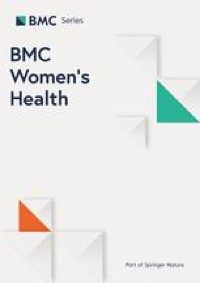
Study sample
A secondary data analysis was conducted using data from the 2011–2012, 2013–2014, 2015–2016, and 2017–2018 US National Health and Nutrition Examination Survey (2011-18 NHANES). NHANES is a national survey that includes a representative sample of the US population, using a complex staged sampling method. NHANES is comprised of two components: an interview and an examination. The NHANES in-person interview was conducted in the participant’s home. The NHANES examination was conducted in the Mobile Examination Center (MEC). The 2011-18 NHANES cycles were approved by the National Center for Health Statistics Ethics Review Board (protocol #2011-17 and protocol #2018-01).
For this secondary data analysis we identified 5,111 woman participants aged 20–45 years from the 2011-18 NHANES datasets. This age range was selected to include most adult mothers of YC, considering the age range for reproductive years among American women giving birth [14]. Among the 5,111 women, we excluded 219 (3.9%) who self-identified as multi or other races than Asian, Black, Hispanic, or White, resulting in 4,892 women for data analysis. We did not exclude women who reported being pregnant (n = 247), because PA is recommended even during pregnancy; at least 150 min of moderate-intensity PA per week [2].
Measurements
Exposure: Type of children living in the same household. During the interview, a demographic survey was administered, which included questions about the total number of YC living in the same household and the total number of older children aged 6–17 years (OC) living in the same household with the participant. However, it did not ask about the relationships (e.g., child, relative) between the participant and the other household member(s). Therefore, adopting the approach used by Adamo et al. [15], we defined women who reported at least one YC and no OC living in the same household (women with YC, hereafter) as mothers of YC. In the same manner, we defined women who reported at least one OC and no YC living in the same household (women with OC, hereafter) as mothers of OC. Women who reported both YC and OC living in the same household (women with YC and OC, hereafter) were defined as mothers of YC and OC. Women who reported no children aged 17 years or under living in the same household (women without children, hereafter) served as a comparison group. As a result, the variable for the type of children living in the same household had four categories: no-children, YC, OC, and YC and OC (YC + OC).
Moderator: Racial and ethnic background. The demographic survey asked participants to self-identify their Hispanic origin (Hispanic or non-Hispanic) and race. Those who self-identified as Hispanic origin were classified as Hispanic, regardless of race. Those who self-identified as non-Hispanic origin were classified as Asian, Black, White, and multi or other race, based on their race response. The multi or other race group was excluded from this study.
Outcome: Physical activity. Among PA domains, this study focused on transportation and leisure-time PA, but not occupational PA or housework PA. Occupational PA was excluded to be aligned with the US Center for Disease Control and Prevention (CDC)’s report that evaluated the national prevalence of physical inactivity outside of work [16]. Also, in consideration of future intervention development, occupational PA is less modifiable as compared to transportation and leisure-time PA. Housework PA was not considered because it was not assessed in the 2011-18 NHANES PA questionnaire (PAQ).
During the interview, a PAQ was administered. The PAQ asked about the frequencies and durations of occupational, transportation, and leisure-time PA in a typical week. For transportation PA, participants were asked “In a typical week, on how many days do you walk or bicycle for at least 10 minutes continuously to get to and from places?”; and “How much time do you spend walking or bicycling for travel on a typical day?” For leisure-time PA, questions about engagement in vigorous-intensity and moderate-intensity PA were asked separately: “In a typical week, on how many days do you do vigorous-intensity sports, fitness, or recreational activities?; “How much time do you spend doing vigorous-intensity sports, fitness, or recreational activities on a typical day?”; “In a typical week, on how many days do you do moderate-intensity sports, fitness, or recreational activities that cause a small increase in breathing or heart rate such as brisk walking, bicycling, swimming, or volleyball for at least 10 minutes continuously?”; and “How much time do you spend doing moderate-intensity sports, fitness, or recreational activities on a typical day?”
Weekly transportation moderate- and vigorous-intensity PA (MVPA) minutes (minutes/week) were calculated by multiplying the frequency (days/week) and duration (minutes/day) of transportation PA. Weekly leisure-time MVPA minutes (minutes/week) were calculated by summing weekly leisure-time vigorous-intensity PA minutes and weekly leisure-time moderate-intensity PA minutes. Weekly transportation MVPA minutes and weekly leisure-time MVPA minutes were summed to calculate overall weekly MVPA minutes. Physical inactivity was defined as participating in zero minutes of overall MVPA in a typical week.
Confounding factors. We considered the following potential confounding factors: age in years, marital status, education, employment, pregnancy status, family income, and body mass index (BMI). During the interview, the demographic survey asked about age in years, marital status (categorized into married, living with a partner, and widowed/divorced/separated/never married), education level (categorized into ≤ high school graduate, some college or Associate in Arts degree, and ≥ college graduate), employment (categorized into employed and non-employed), pregnancy status (categorized into pregnant, not pregnant, and unknown), family income, and family size. A poverty index ratio, a ratio of family income to poverty, was calculated based on family size and income and then categorized into < 1.0 (below the current US poverty level; low income), 1 to < 3.0 (middle income), and ≥ 3.0 (high income). Anthropometry (height and weight) assessments were conducted in the MEC. BMI was calculated as weight (kg) divided by height squared (m2) and categorized into < 25, 25 to < 30, and ≥ 30 kg/m2.
Statistical analysis
All analyses were conducted using SAS 9.4 survey procedure (Cary, NC), accounting for the complex sample design, such as weighting and clustering. Descriptive analyses, including distribution analyses, for all study variables were conducted. No missing data were found for any study variables, except family income and BMI categories which were treated using a median imputation method: those with missing data for the poverty index ratio (n = 444; 10%) were assigned to the middle-income category, and those with missing data for BMI (n = 236; 5%) were assigned to the middle category, 25 to < 30 kg/m2. The means and proportions of the PA variables were compared between women living with YC and without children in each of the four racial and ethnic groups, using 95% confidence intervals (CIs).
Multivariable logistic regression analyses were conducted, stratified by racial and ethnic groups to compare the probability of physical inactivity by the type of children living in the same household (reference: no-children group) within each racial and ethnic group. In the regression analyses, we included the following confounding factors as predictors: age in years, marital status, education level, employment, poverty index ratio category, and BMI category. Odds ratios (ORs) and 95% CIs were obtained from the logistic regression models. In sensitivity analysis, multivariable logistic regression analysis was repeated following the steps previously outlined but excluding participants who were pregnant. We also repeated the analysis excluding those with missing data for poverty index ratio or BMI to evaluate the impacts of the imputations on the regression analysis results. To explore a dose-response relationship between the number of children living in the household and physical inactivity, an exploratory analysis was conducted using the number of YC (0, 1, or ≥ 2) and the number of OC (0, 1, or ≥ 2) in the household as predictors in multivariable logistic regression models. To explore the effects of immigration status, logistic regression analysis was conducted, additionally including the immigration status variable, identified by birthplace (foreign-born vs. US-born).
Among those who reported engaging in at least one minute of MVPA in a typical week, multivariable linear regression analyses were conducted stratified by racial and ethnic group to compare weekly MVPA minutes by the type of children living in the same household (reference group: no-children). Because the distribution of the weekly MVPA minute variable showed a long tail on the right side due to outliers, values above the 99th percentile (> 720 min) were recoded as 720 min to improve the distribution. These linear regression analyses included the same set of predictors as the multivariable logistic regression analyses described above. A significance level was set at 0.05 (two-sided).




